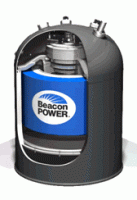 The California Energy Commission today announced that an innovative flywheel energy technology to enhance California’s electricity grid is now one step closer to commercialization. The Smart Energy Matrix system, developed by Beacon Power’s, is a 100-kilowatt scale-power flywheel energy storage system and a prototype for Beacon’s planned 20-megawatt-level commercial system.
The California Energy Commission today announced that an innovative flywheel energy technology to enhance California’s electricity grid is now one step closer to commercialization. The Smart Energy Matrix system, developed by Beacon Power’s, is a 100-kilowatt scale-power flywheel energy storage system and a prototype for Beacon’s planned 20-megawatt-level commercial system.
Check out a flash animation of how this technology would be used to regulate the grid. This regulation feature could also be used to do the same for variable output renewable technologies like wind or solar. See a very good video of how these techs would work with renewable energy and how the energy market works here.
“We’re grateful for the consistent and effective support we’ve received from the Energy Commission throughout the project,” said Bill Capp, Beacon Power president and CEO. “We’re also very pleased that our technology has been certified by the California ISO, which we announced earlier this week. These two important authorities, in conjunction with the U.S. Department of Energy, are demonstrating energy policy leadership and vision. They understand that new technologies will be required to maintain grid reliability while achieving ambitious goals for the deployment of renewable energy and the reduction of carbon emissions.”
“The application of new energy storage technologies is a high priority as California upgrades its electricity grid system. The Energy Commission is pleased at the results of Beacon’s testing and the potential for use of this technology in California,” said Energy Commissioner John Geesman. “California has made a significant commitment to deploy renewable energy placing greater demands on the state’s electric grid. Technologies such as Beacon’s flywheel-based energy storage system provide attractive options to address these emerging issues.”
Beacon Power completed the Critical Project Review (CPR), a significant milestone that assesses the status of research contracts and validates that the contractor is complying with the terms of the contract. The CPR evaluates the field performance of the flywheel system and recommends any final actions required to complete a full assessment of this innovative technology. The flywheel system is actually a kinetic, or mechanical battery, spinning at very high speeds to store energy that is instantly available when needed.
In addition to the environmental and transmission benefits of flywheel technology, current research at Lawrence Berkeley National Laboratories indicates that 10 megawatts of fast-responding flywheel energy could provide the grid with the equivalent energy of 20 megawatts or more of traditional slow-responding power plant energy. Flywheel technology also serves as a method to reduce electrical fluctuations and helps regulate the even flow of power (frequency regulation) on the grid.
Grid operators, such as the California ISO, purchase frequency regulation services every day. In 2005, the value of regulation services purchased by four U.S. regional grid operators in open power markets was in excess of $600 million. California ISO’s David Hawkins states, “A 40-megawatt facility, or two of the plants that Beacon is designing under a Department of Energy contract, could provide a portion of the regulation services required by California ISO. Due to its very high-speed rate, this technology also has the potential to provide valuable transmission grid services and reduce greenhouse gas emissions.”
The California Energy Commission contracted with Massachusetts-based Beacon Power in 2005, to develop and install a system to demonstrate the potential benefits of using flywheel energy storage for frequency regulation of the grid, a service required by all grid operators.
The system first became operational in 2005 and completed a series of performance tests and technical assessments prior to a six-month field trial phase on August 1, 2006. Field demonstration testing of the Beacon Smart Energy Matrix will continue until January 31, 2007. After that, the Energy Commission and DOE will review all the performance data collected over the six-month period and produce a publicly available report summarizing the testing program, results and recommendations. The Department of Energy (DOE) Energy Storage Systems Program Office, through Sandia National Laboratories, is also providing technical assistance to the Energy Commission for this contract.